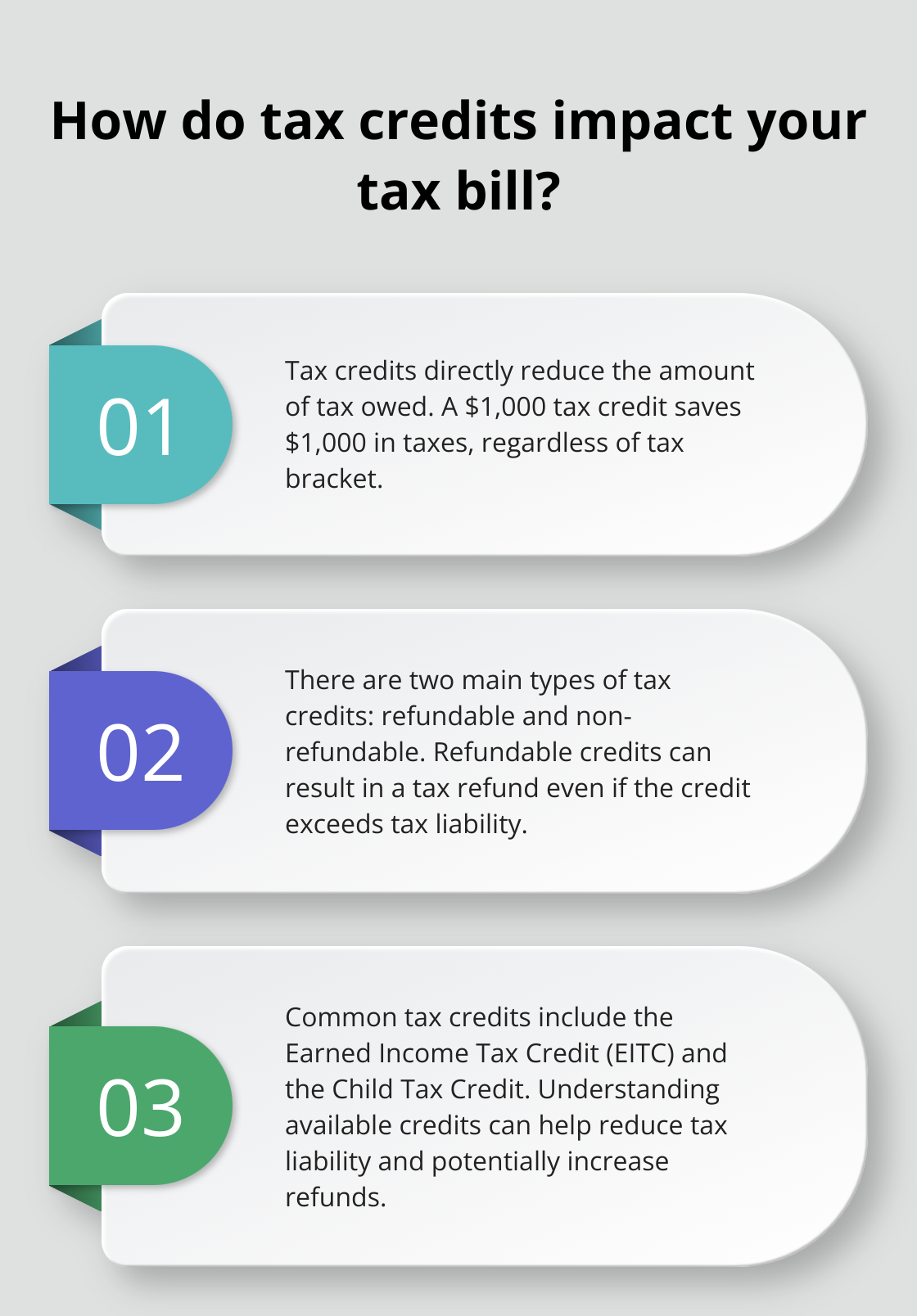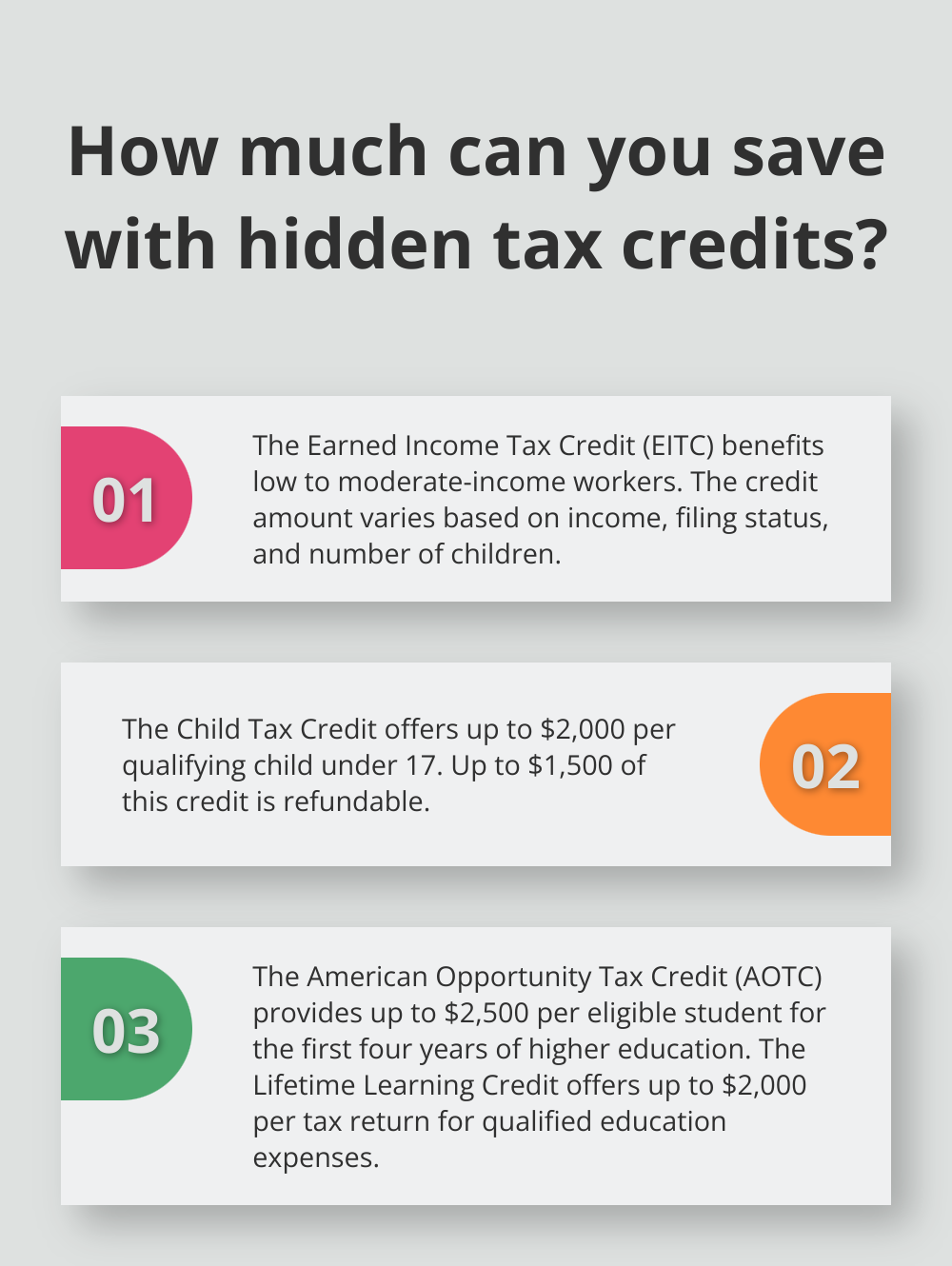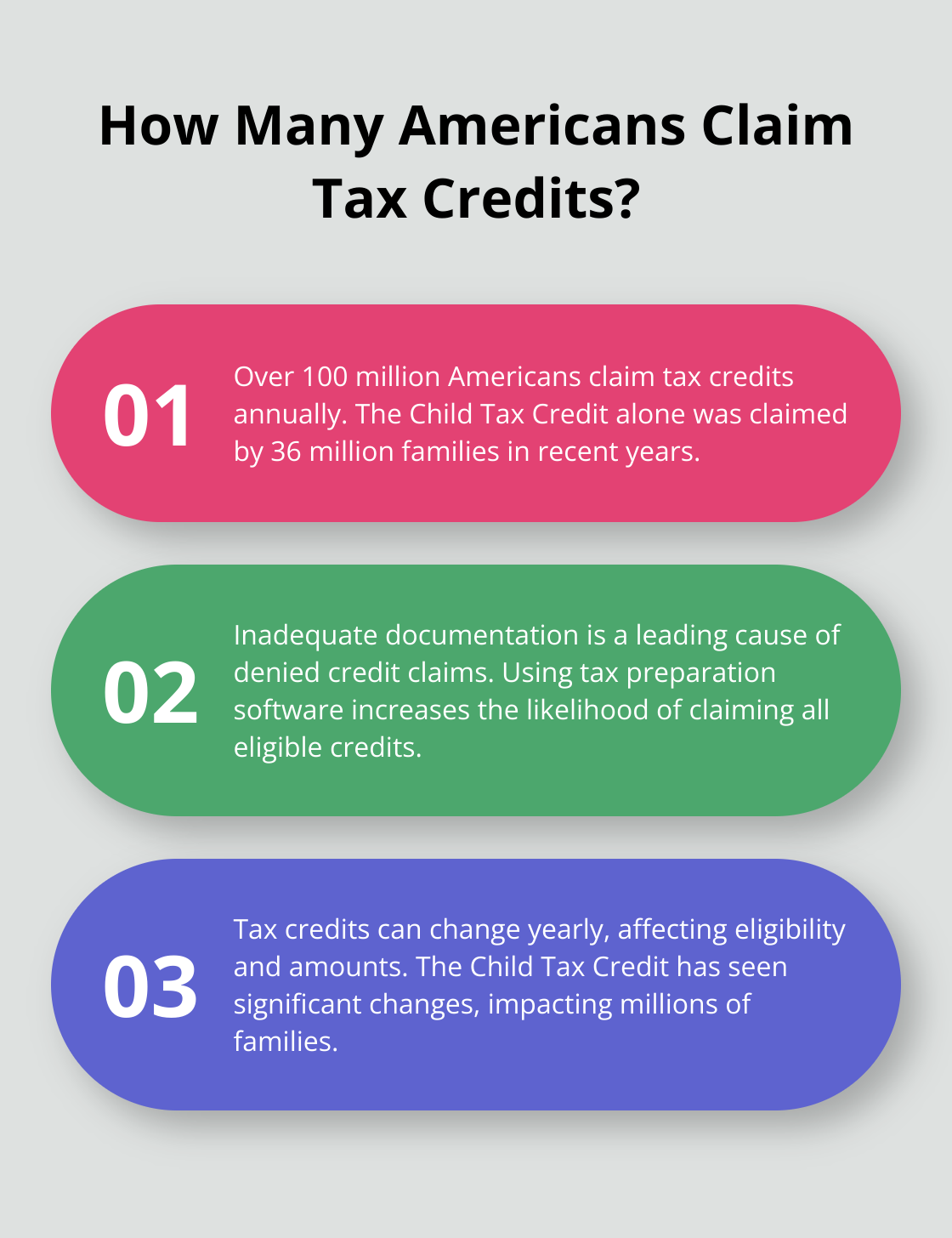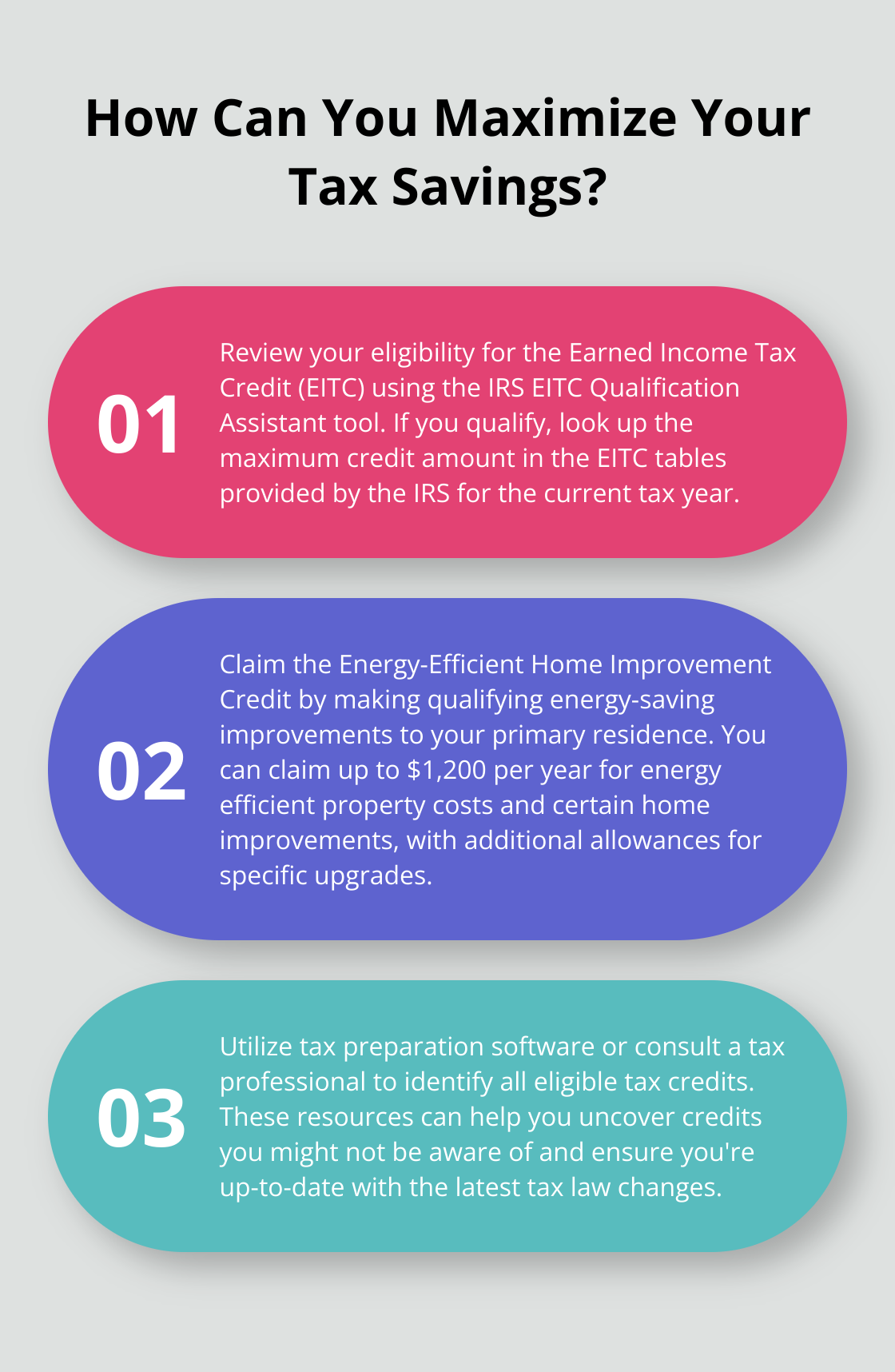Tax credits can significantly reduce your tax bill, but many taxpayers overlook these valuable opportunities. At 7B Bookkeeping & Tax LLC, we often see clients missing out on potential savings simply because they’re unaware of their tax credit eligibility.
In this post, we’ll explore some commonly overlooked tax credits and how you can claim them. Understanding these credits could put more money back in your pocket come tax season.
What Are Tax Credits and How Do They Work?
Tax credits are powerful tools that can significantly reduce your tax bill. Unlike deductions, which lower your taxable income, tax credits directly decrease the amount of tax you owe. This means a $1,000 tax credit saves you $1,000 in taxes, regardless of your tax bracket.
The Direct Impact of Tax Credits
Tax credits provide a dollar-for-dollar reduction in your tax liability. For example, if you owe $5,000 in taxes and qualify for a $2,000 tax credit, your tax bill drops to $3,000. This direct impact makes tax credits particularly attractive for taxpayers who want to maximize their savings.
Types of Tax Credits
There are two main types of tax credits: refundable and non-refundable.
Refundable Credits
Refundable credits can result in a tax refund even if the credit amount exceeds your tax liability. For instance, if you owe $500 in taxes and qualify for a $1,000 refundable credit, you’ll receive a $500 refund.
Non-Refundable Credits
Non-refundable credits can only reduce your tax liability to zero. Any excess credit amount is lost. While still valuable, these credits won’t result in a refund if they exceed your tax bill.
Common Tax Credits
To make the most of tax credits, it’s important to understand which ones you qualify for and how to claim them. Some common credits include:
- The Earned Income Tax Credit (EITC)
- The Child Tax Credit
- The American Opportunity Tax Credit (for education expenses)
- The Retirement Savings Contributions Credit (for contributions to retirement accounts)

Understanding these credits (and others you might qualify for) can help you reduce your tax liability and potentially increase your refund. The next section will explore some of the most valuable tax credits that taxpayers often overlook.
Hidden Tax Credits That Could Save You Thousands
Many taxpayers miss out on valuable tax credits because they don’t know about their existence or eligibility. Let’s explore some of the most impactful tax credits you might overlook.
The Earned Income Tax Credit: A Game-Changer for Low to Moderate Earners
The Earned Income Tax Credit (EITC) benefits low to moderate-income workers. If you are unsure if you can claim the EITC, use the EITC Qualification Assistant. The IRS provides EITC tables to look up maximum credit amounts by tax year.

To qualify, you must have earned income from employment or self-employment and meet specific income thresholds. These thresholds vary based on your filing status and number of children.
Child Tax Credit: More Than Just for Parents
The Child Tax Credit offers up to $2,000 per qualifying child under 17. This credit isn’t limited to parents. Legal guardians, grandparents, and other relatives caring for children may also qualify. Up to $1,500 of this credit is refundable, meaning you could receive it even if you don’t owe taxes.
Income limits for the full credit are $200,000 for single filers and $400,000 for married couples filing jointly. The credit begins to phase out for incomes above these thresholds.
Education Credits: Offsetting the Cost of Higher Learning
The American Opportunity Tax Credit (AOTC) provides a credit of up to $2,500 per eligible student for the first four years of higher education. This credit is partially refundable (up to $1,000 available even if you owe no taxes). To qualify, the student must pursue a degree, enroll at least half-time, and meet income requirements.
For those beyond their first four years of post-secondary education, the Lifetime Learning Credit offers up to $2,000 per tax return for qualified education expenses. This credit has no limit on the number of years you can claim it, making it valuable for graduate students or those pursuing professional development courses.
Retirement Savings Contributions Credit: Double Your Savings
The Retirement Savings Contributions Credit (also known as the Saver’s Credit) rewards low to moderate-income taxpayers for contributing to retirement accounts like IRAs or 401(k)s. The credit is worth up to 50% of your contributions, with a maximum credit of $1,000 ($2,000 if married filing jointly).
For 2024, single filers with an adjusted gross income of $36,500 or less can claim the full credit. The credit phases out completely at $73,000 for married couples filing jointly.
Energy-Efficient Home Improvement Credit: Save on Taxes and Energy Bills
Homeowners can benefit from the Energy-Efficient Home Improvement Credit when they make qualifying energy-saving improvements to their primary residence. The maximum credit you can claim each year is $1,200 for energy efficient property costs and certain energy efficient home improvements, with additional allowances for specific improvements.
This credit not only reduces your tax bill but also leads to long-term savings on energy costs. It’s a win-win for both your wallet and the environment.
Now that we’ve explored these often-overlooked tax credits, you might wonder how to claim them effectively. In the next section, we’ll discuss the steps you need to take to ensure you don’t miss out on these valuable opportunities.
How to Maximize Your Tax Credit Claims
Gather Essential Documentation
The first step to claim tax credits involves collecting all necessary documentation. This includes W-2 forms, 1099 forms, receipts for qualifying expenses, and other relevant financial records. For education credits, collect tuition statements (Form 1098-T) and receipts for course materials. If you claim energy-efficient home improvement credits, keep invoices and manufacturer certifications for eligible products.

The IRS reports that inadequate documentation often results in denied credit claims. Organize your documents throughout the year to avoid last-minute rushes and potential oversights.
Use Tax Preparation Software
Modern tax preparation software can help identify and claim eligible tax credits. These programs often include questionnaires that uncover credits you might not know about. They also typically update with the latest tax law changes, which ensures you’re aware of new or modified credits.
A study by the Government Accountability Office found that taxpayers who use tax preparation software claim all the credits they’re eligible for more often compared to those who file manually.
Seek Professional Assistance
While software can help, working with a tax professional often provides the most comprehensive approach to maximize your tax credits. Tax laws are complex and change constantly. A qualified tax preparer stays current with these changes and can identify credits you might overlook.
Tax professionals have extensive experience in identifying and claiming tax credits for their clients. They help individuals and businesses maximize their tax savings through careful credit analysis and application.
Stay Informed About Credit Updates
Tax credits can change from year to year. The IRS regularly updates credit amounts, income thresholds, and eligibility criteria. For instance, the Child Tax Credit saw significant changes in recent years, which affected millions of families.
Review IRS publications or consult with a tax professional before filing. This proactive approach ensures you don’t miss out on new or expanded credit opportunities.
Final Thoughts
Tax credits offer significant opportunities to reduce your tax liability and increase your refund. Many taxpayers miss out on these valuable credits due to lack of awareness about their tax credit eligibility. We at 7B Bookkeeping & Tax LLC specialize in helping individuals and businesses navigate the complex world of tax credits and deductions.

Our team of experts (including a Chartered Tax Professional and Enrolled Agent) provides comprehensive financial services, such as expert tax preparation, bookkeeping, and financial consulting. We offer secure, remote tax preparation and reliable IRS representation to ensure you maximize your tax savings and minimize your liabilities. Our flat-rate bookkeeping service includes account reconciliation and payroll management via QuickBooks Online.
Don’t leave money on the table when it comes to your taxes. Let 7B Bookkeeping & Tax LLC help you identify and claim all the tax credits you’re eligible for, ensuring you get the maximum benefit from your tax return. Contact us today to learn how we can help you optimize your tax strategy and achieve your financial goals.

